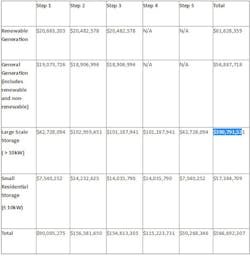Pacific Gas and Electric (PG&E) is inviting businesses and consumers to apply for $240 million in renewable and energy storage incentives through its self-generation incentive program (SGIP) for 2017.
California regulators have directed PG&E and other investor-owned utilities to distribute $566,692,308 designated to the SGIP program through 2019.
The bulk of the money – 79 percent will be used for energy storage incentives. The remaining 21 percent will go to projects that use generation, such as wind turbines, fuel cells and combined heat and power.
PG&E says it will prioritize applications that pair energy storage with renewables.
The SGIP was developed in 2001 by the state legislature and the California Public Utilities Commission (CPUC) to boost renewables and support California’s climate and clean air goals.
This year marks the first time most of the money is designated for energy storage. More than $390 million will go to energy storage projects bigger than 10 kW in size. For smaller, residential-size storage projects, the state allocated $57 million.
Energy storage incentives will vary based on the size of the project and other factors.
For example, the incentive will be 50 cents/watt-hour for projects that do not take the federal investment tax credit (ITC). Residential systems that are 10 kW and smaller will receive the same incentive. For larger energy storage projects that take the ITC, the incentive begins at 36 cents/watt-hour. As funds deplete, the incentive levels go down in 10 cents/watt-hour increments. The money is being alloted in five stages, with the first step opening up May 1.
Funds Available Statewide through California SGIP
Source: California PUC
Incentives differ for generation projects. For example, wind energy starts at 90 cents/watt, while CHP and fuel cell projects start at 60 cents/watt. Like energy storage, generation projects see incentives decline based on demand.
“Incentives for energy technologies offered through the statewide self-generation incentive program allow our customers to have choice and control over their energy,” said Aaron Johnson, PG&E vice president of customer energy solutions. “We applaud California’s direction allocating nearly 80 percent of the program to energy storage, a growing resource as we continue integrating distributed energy resources for the energy grid of the future.”
More details about the offering are available at www.selfgenca.com/.







